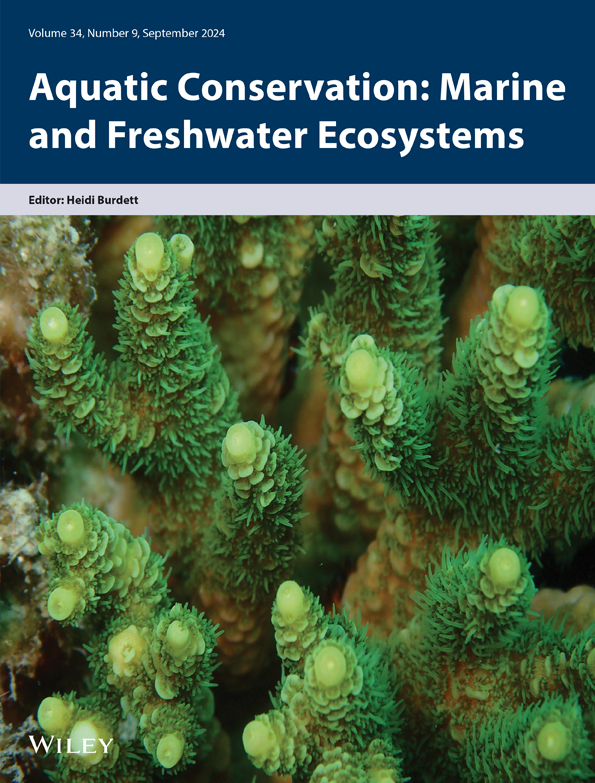Exploring the Potential of Seed-Based Dwarf Eelgrass (Zostera noltii) Restoration
Funding: This project was funded by Rijkswaterstaat.
ABSTRACT
- Dwarf eelgrass, Zostera noltii, is an important ecosystem engineer that creates dense meadows along the coasts of Europe and Northwest Africa. During the last century, this seagrass species suffered severe population declines, and to counteract these losses, restoration has emerged as an important management tool. Thus far, restoration efforts with Z. noltii have only been performed with shoot- and core-based methods, which are challenging to upscale sustainably.
- Here, we explored if Z. noltii can be restored with seeds, thus potentially offering an upscalable solution for future restoration efforts. With the newly developed dispenser injection seeding (DIS) method, we tried seed-based Z. noltii restoration in the intertidal Wadden Sea. With a field experiment, we investigated how seeding depth (1.5 and 3 cm) and seed amount (5, 10 and 20 seeds/injection) affected Z. noltii recruitment success and efficiency.
- Most importantly, our results show that Z. noltii can be restored with seeds, as 3 months after seeding, 184 individual patches had emerged from our 7000 seeds (2.6% recruitment). Recruitment success (number of restored patches/plot) was enhanced by higher seed amounts (20 > 5 seeds/injection), while the opposite was true for recruitment efficiency (number of restored patches/seed), which was reduced by higher seed amounts (20 < 5 seeds/injection). Restored Z. noltii survived the first winter in all experimental plots, but seagrass cover (square metre/plot) reduced in two-thirds of the plots compared to the first growing season.
- In conclusion, our findings show the potential of seed-based Z. noltii restoration and provide insights on how upscaling of restoration efforts for this species can be performed more efficiently and sustainably in the future.
1 Introduction
Dwarf eelgrass (Zostera noltii) is a marine flowering plant that forms dense meadows along the coasts of Europe and Northwest Africa. This species is one of four native seagrass species found in Europe. Like other seagrasses, Z. noltii is an important ecosystem engineer that creates beneficial living conditions for itself and associated species through habitat modification. This species also produces several vital ecosystem services ranging from carbon sequestration to coastal defence (Potouroglou et al. 2021; Paul and Amos 2011). However, during the last century, Z. noltii and seagrasses in general have experienced large declines caused mainly by anthropogenic impacts (e.g., coastal development and eutrophication; de los Santos et al. 2019; van Katwijk et al. 1999; Philippart 1994). Fortunately, Z. noltii has lately shown remarkable recovery in the Northern Wadden Sea (Dolch et al. 2013). However, this positive trend has not been observed everywhere (de los Santos et al. 2019). For instance, in the Dutch Wadden Sea, Z. noltii has shown no recovery despite significant reductions in eutrophication, its main stressor (Dolch et al. 2017).
In addition to passive conservation efforts, ecological restoration has become an important management tool in the fight against global ecosystem degradation. Restoration efforts targeting Z. noltii have been performed across Europe (e.g., Suykerbuyk et al. 2018; Valle et al. 2015; Costa et al. 2022; van Katwijk et al. 2009), with the ultimate goal of aiding large-scale recovery. Restoration approaches vary from large-scale mitigation projects performed with sods (Suykerbuyk et al. 2018) to shoot-based experimental work (van Katwijk et al. 2009). These efforts have had varying successes but ultimately show that although challenging, long-term restoration success of this species is achievable (Suykerbuyk et al. 2018). Historically, Z. noltii has received much less attention from restoration practitioners compared to other seagrass species (especially Zostera marina; van Katwijk et al. 2016). However, recently, several ambitious restoration targets have been set for the species in Europe (e.g., for the Wadden Sea, the Bay of Arcachon in France and coastal areas around the United Kingdom). For instance, in the Netherlands, the government has a legal task to restore over 6600 ha of Z. noltii meadows by 2027. For such large restoration scales, shoot- and core-based methodologies are suboptimal, as they are challenging to upscale without causing severe damage to donor meadows. Thus, new approaches that enable upscaling are desperately needed (Abelson et al. 2020).
One potential way to solve the issue of upscaling is the use of seed-based restoration methods. Seed-based methods are generally considered more scalable than methods that rely on established plants (e.g., cores or shoots), because they are less expensive and logistically more feasible (Kettenring and Tarsa 2020 and references within). Using seeds also increases the genetic diversity of the restored meadows, which has been shown to be an important contributor to long-term restoration success (e.g., Procaccini and Piazzi 2001; Reynolds et al. 2012). Importantly, these methods can also be upscaled more sustainably, as harvesting of large amounts of seeds is less damaging to donor sites than harvesting cores or shoots. Therefore, it is important to explore the feasibility and potential of seed-based Z. noltii restoration.
Here, we aimed to take the first steps to develop seed-based dwarf eelgrass (Z. noltii) restoration to enable sustainable future large-scale restoration efforts. For this, we performed a seeding experiment in the intertidal Dutch Wadden Sea with the dispenser injection seeding (DIS) method (Govers et al. 2022). The DIS method has proven to be effective for the restoration of annual common eelgrass (Z. marina; Gräfnings et al. 2022, 2023), but the method's suitability for other seagrass species and perennial plants remains unknown. We investigated how seeding depth and seed amount (seeds/injection) affected Z. noltii recruitment success and efficiency. Considering and actively improving recruitment efficiency have recently been highlighted as an important way to improve scalability potential of restoration efforts (Gräfnings et al. 2023). Optimal seeding depth has been shown to be an important contributor to Z. marina seedling recruitment (Gräfnings et al. 2022). We hypothesized that shallower seeding depth would facilitate Z. noltii recruitment, as long as the seeds were not more likely to be washed away closer to the surface. We expected higher seed amounts to increase recruitment success. However, we also hypothesized that higher seed amounts might lower recruitment efficiency if seed viability was high enough to enable a few seeds to consistently recruit Z. noltii. Therefore, we wanted to determine a specific seed amount that both enabled patch recruitment and kept recruitment efficiency as high as possible.
2 Methods
2.1 Study Species
Dwarf eelgrass (Z. noltii) is a perennial seagrass species that is most commonly found in the intertidal zone but can also grow in the shallow subtidal. Z. noltii meadows can be found along the Atlantic coast from southern Norway all the way south to Senegal (Sidi Cheikh et al. 2023). Additionally, the species grows in the Baltic, Mediterranean, Black, Caspian and Azov Seas (Green and Short 2003). The plant can reproduce both asexually and sexually. In its southern distribution area, the species is leaf bearing throughout the year and produces few seeds, while in northern Europe, the plants overwinter as small rhizome fragments with few or no leaves and produce significantly more seeds (Vermaat and Verhagen 1996; van Tussenbroek et al. 2016; Govers et al. 2015).
2.2 Study Area
The restoration trial was performed north-east of Griend island (N 53.2692, E 5.2949) in the Dutch Wadden Sea (Figure 1). The island is surrounded by a large (~5000 ha) intertidal sandflat that emerges for ~6 h twice a day during low tide. The restoration site was selected because since 2018, restoration trials with common eelgrass (Z. marina) have been successfully performed at the site (Gräfnings et al. 2022, 2023). Initially, the site was selected because the spontaneous establishment of Z. noltii and Ruppia maritima was observed at the site between 2014 and 2017. However, no Z. noltii grew in the area of the sandflat where this restoration trial was performed.
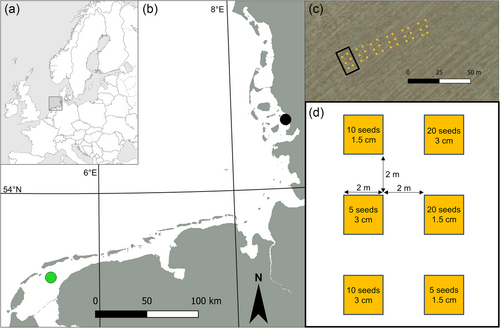
2.3 Seagrass Restoration Method
Intertidal Z. noltii seeds were collected in August 2021 at Hamburger Hallig (N 54.5986, E 8.8111) in the German Wadden Sea (Figure 1). During low tide, the tip of seed-bearing shoots (cut directly below the seed spathe) was manually harvested by volunteers. We estimate that the collection of seed-bearing shoots, which after processing resulted in 7000 seeds, took 21 people hours. On the same day, donor material was transported to the Netherlands for overwinter storage. The seed-bearing shoots were placed in a seawater-filled basin and aerated until seeds were released. Seeds were treated and stored similarly to Z. marina seeds (Govers et al. 2022), including seed treatment with copper sulfate (0.2 ppm, Govers et al. 2017). We estimate that individual seed-bearing shoots (each with one spathe) on average resulted in 1.75 usable seeds after all the processing steps. The viability of the seeds was tested in vitro at two salinities (15.0 and 28.5 ppt). In order to break dormancy, all seeds were washed with fresh water three times and afterwards soaked for 24 h in demi water (0 ppt). After soaking, three 12-well clear sterile plates were prepared per salinity, with one individual seed placed in each well (36 seeds/salinity). The seeds were given 12 weeks to germinate, from early December 2021 to mid-March 2022. At the end of the germination period, 30.6% of the tested Z. noltii seeds had germinated at 15.0 ppt while none of the seeds germinated at 28.5 ppt. For comparison, Z. marina seeds from plants with an annual life history showed higher germination rates (57.4% at 15.0 ppt and 25.9% at 28.5 ppt) in an identical test that was performed simultaneously.
Seeding was performed with the DIS method (Govers et al. 2022; Gräfnings et al. 2022). For this method, a sediment–seed mixture is injected into the mudflat sediment with a caulking gun. The nozzles of the caulking guns were marked to achieve the targeted seeding depths.
2.4 Restoration Trial
In March 2022, we conducted a field experiment to test the potential of the seed-based restoration of Z. noltii. We tested the effect of seed amount (three levels: 5, 10 or 20 seeds/injection) and injection depth (two levels: 1.5 or 3 cm) on recruitment success and efficiency over two growing seasons. In this study, we calculated recruitment efficiency by dividing the number of realized Z. noltii patches/plot (recruitment success) with the initial seed amounts (seeds/plot), thus acquiring an estimate for how many Z. noltii patches each individual seed resulted in. The full factorial randomized field experiment had six treatments each replicated six times (in total 36 plots sown with 7000 seeds). Plots had an area of 4 m2 (2 × 2 m) and were separated from each other by 2 m. In each plot, 16 injections were seeded evenly across the area with the DIS method (four injections/m2). The seeding was performed during one low tide by one person and took approximately 2 h.
In June 2022, the experiment was monitored for the first time after seeding. We counted the number of emerged Z. noltii patches in each experimental plot. In June, individual patches were still small (diameter: ~10 cm, Figure 3). Each established patch could be linked to a single seed injection, because seeding had been performed so sparsely (four injections/m2) and evenly across the plots. In August 2022, the experimental plots were revisited. In most plots, the individual patches recorded in June had merged, making recounting of individual patches impossible. Instead, we surveyed the experimental area with a drone (DJI Mavic 2, Hasselblad F/2.8 EQV 28-mm camera, 12-m altitude) and used the georeferenced orthophoto to calculate the cover (square metre) of Z. noltii in each experimental plot in QGIS (long-term release, Version 3.28, Firenze). In several plots, Z. noltii had spread outside the initial plot boundaries. We included these outgrowths to the cover estimates, when it was clear that the expansion had occurred from within a certain experimental plot. In August 2023, we revisited the experiment to monitor patch survivability and to repeat the drone procedure from the year before. In 2023, the camera of the drone malfunctioned at the end of the flight, which resulted in four of the experimental plots not being caught in the imagery.
2.5 Statistical Methods
We used two-way ANOVAs (post hoc: Tukey's HSD) to investigate how seeding depth (1.5 or 3 cm) and seed amount (5, 10 or 20 seeds/injection) affected recruitment success (number of restored patches/plot) and recruitment efficiency (number of restored patches/seed) in June 2022 and percentage of Z. noltii cover/plot in August 2022. Prior to analysis, data were tested for normality to meet the assumptions of parametric tests. Additionally, we used a linear regression to investigate the relationship between the number of established Z. noltii patches in June and Z. noltii cover in August 2022. A paired-samples Wilcoxon test was used to compare the Z. noltii cover between the 2 years (plot ID was used as pairing). The four plots that were missing cover data from 2023 due to drone malfunction were excluded from this analysis. All data were analysed in R Version 4.0.3 (R Core Team 2020).
3 Results
In June 2022, a total of 184 Z. noltii patches were recorded in the 36 experimental plots at Griend. Patches emerged in all except one experimental plot. Recruitment success differed significantly between seed amounts, F(2, 30) = 4.106, p = 0.027 (Figure 2A and Table 1), with the highest amount (20 seeds/injection; 6.75 patches/plot ± 0.95 SEM) increasing patch recruitment compared to the lowest seed amount (five seeds/injection; 3.75 patches/plot ± 0.63 SEM). Seeding depth or the interaction between seeding depth and seed amount did not significantly affect patch recruitment. Recruitment efficiency (measured as established Z. noltii patches/seed) also differed significantly between seed amounts, F(2, 30) = 5.797, p = 0.007 (Table 1 and Figure 2B). However, opposite to recruitment success, recruitment efficiency was more than doubled by the lowest amount (five seeds/injection; 0.047 patches/seed ± 0.008 SEM) compared to the highest (20 seeds/injection; 0.021 patches/seed ± 0.003 SEM). In other words, with the lower seed amount (five seeds/injection), 5% of the seeds resulted in a patch (1 in 20 seeds), while with the higher seed amount, on average, 50 seeds were needed to establish a patch (2% efficiency). Seeding depth or the interaction between seeding depth and seed amount did not significantly affect recruitment efficiency.
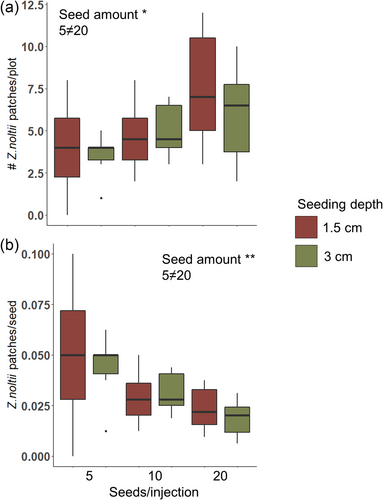
| June 2022 | August 2022 | ||||||||
|---|---|---|---|---|---|---|---|---|---|
| Recruitment success (Z. noltii patches/plot) | Recruitment efficiency (established Z. noltii patches/seed) | Z. noltii cover (m2/plot) | |||||||
| Sum Sq (df) | F | p | Sum Sq (df) | F | p | Sum Sq (df) | F | p | |
| Seeding depth (A) | 2.78 (1) | 0.412 | 0.526 | 0.0001 (1) | 0.222 | 0.641 | 0.34 (1) | 0.141 | 0.709 |
| Seed amount (B) | 55.39 (2) | 4.106 | 0.0265* | 0.0041 (2) | 5.797 | 0.007** | 11.86 (2) | 2.461 | 0.102 |
| A × B | 5.06 (2) | 0.375 | 0.691 | 0.0001 (2) | 0.166 | 0.848 | 0.59 (2) | 0.123 | 0.885 |
| Residuals | 202.33 (30) | 0.0106 (30) | 72.31 (30) | ||||||
- * Significance of <0.05,
- ** Significance of <0.01.
In August 2022, the initial patches had grown visibly (Figure 3) and Z. noltii covered on average 2.8 m2/plot. Z. noltii cover was not significantly affected by the initial treatments (Table 1 and Figure 4A), but the linear regression revealed that higher Z. noltii cover in August 2022 correlated positively with patch recruitment success (Figure 4B; R = 0.78, p < 0.001). Additionally, we observed that Z. noltii was flowering in all plots.
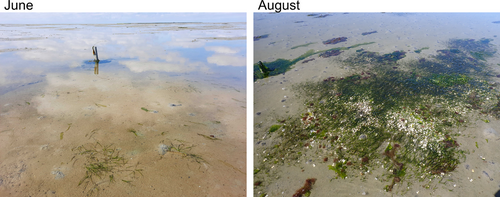
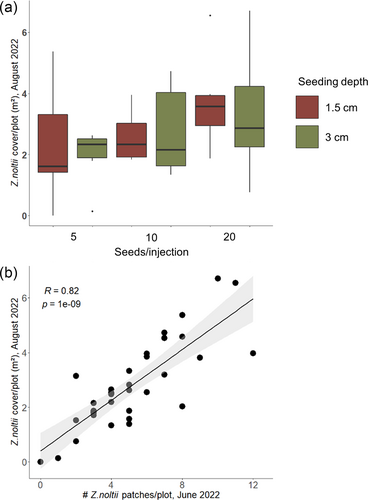
In August 2023, we observed that Z. noltii had survived the first winter in all experimental plots. However, seagrass cover had significantly reduced from the year before, from 2.8 m2/plot to an average cover of 1.9 m2/plot (Figure 5, Wilcoxon signed-rank test, V = 362, p < 0.01). Z. noltii cover showed reduction in 63% of the plots (average reduction: 1.88 m2). We also observed that dozens of new Z. noltii patches had established around the original experimental plots, which with high likelihood had their origin from seeds produced by the restored Z. noltii.
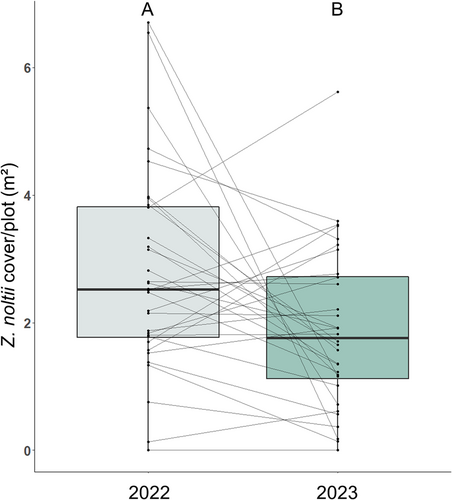
4 Discussion
Despite its importance as a coastal foundation species of high ecological value, Z. noltii has received relatively little attention by restoration practitioners. However, interest in restoration of the seagrass species has recently accelerated, and there is a growing need to develop best practices for upscaling Z. noltii restoration efforts. This study shows that Z. noltii can be successfully recruited from seeds in the field. Of the 7000 seeds sown in spring, 184 patches (2.6% recruitment rate) emerged in the beginning of summer. During the first growing season, patches expanded rapidly and Z. noltii survived the first winter in all restoration plots. The following year, expansion slowed down, and in two-thirds of the plots, seagrass cover even reduced, which highlights the need for long-term monitoring efforts. By showing that Z. noltii can be restored with seeds, we add a new method to the coastal management toolbox, which if further developed has the potential to enable sustainable and large-scale restoration efforts of this valuable but threatened coastal foundation species.
Measuring only survival and recruitment success is rarely a sufficient approach to establish restoration success of a target species (Abelson et al. 2020 and references within). However, these metrics can offer crucial information about the functionality/effectiveness of the chosen restoration strategy and inform practitioners how to optimize restoration efforts. In this study, Z. noltii recruitment success was enhanced by sowing higher seed amounts. With the most successful treatment (20 seeds/injection and 1.5-cm depth), almost every second injection resulted in a restored patch (7.5 patches/plot ± 1.50 SEM). Once established, the patches grew rapidly over the first summer (2.5 months). This ability to expand rapidly has previously been linked to Z. noltii's very high branching rate and moderately fast rhizome elongation (Vermaat and Verhagen 1996; Cunha et al. 2004). Higher recruitment success in turn resulted in higher late summer Z. noltii cover (m2). However, in order to achieve these high patch numbers, high seed amounts were needed (80 seeds/m2), which resulted in a lowered recruitment efficiency in terms of patches produced per injected seed. Even though seeds can be harvested more sustainably in large amounts than sods or shoots, their collection is laboursome and availability limited, which means that seeds need to be used efficiently in order to enable very large-scale restoration efforts. Thus, our results present an interesting dilemma: What is more desirable: achieving high recruitment at any cost or recruitment as efficiently as possible? The answer is going to depend on project-specific goals and practical factors (e.g., available donor material), but we predict that finding a middle ground between the two extremes is often going to be advisable.
The methods we use for ecological restoration matter. The DIS method has previously been found to be a highly effective restoration method for intertidal common eelgrass (Z. marina; Gräfnings et al. 2022, 2023), and our results provide a first indication that this might also apply to Z. noltii. The most efficient treatment (five seeds/injection and 1.5-cm depth) resulted in 0.05 patches/seed, which means that 5% of seeds resulted in a patch. This is a relatively high recruitment efficiency when compared to most published seed-based seagrass restoration results for perennial Z. marina (see, e.g., Marion and Orth 2010; Eriander et al. 2016; Unsworth et al. 2019), but still far less efficient than what has been accomplished at the same site for annual Z. marina with the DIS method (11.4% seed recruitment; Gräfnings et al. 2022). We argue that this difference is likely caused by the lower seed viability of Z. noltii. Dwarf eelgrass is a perennial plant that mainly reproduces asexually, and lower seed viability compared to Z. marina with an annual life history (which relies on successful seed production) was to be expected. Seed viability and germination can potentially be increased if seed treatments that specifically target Z. noltii were to be developed (as has been shown for Z. marina; Govers et al. 2022 and references within). A major benefit of the DIS method is that it is highly adaptable (Gräfnings et al. 2022, 2023), which potentially improves the methods' applicability for a wider array of species. Here, the two seeding depths did not affect Z. noltii restoration results. Still, we recommend the deeper seeding depth (3 cm), because seeding deeper has been found to reduce the risk for dislocation (Marion et al. 2020; Gräfnings et al. 2022). Additionally, we recommend that future restoration efforts in other areas put effort into determining optimal seeding depth, because optimal seeding depth is context dependent and can affect restoration outcomes (Gräfnings et al. 2022). Finally, we note that the low seeding density (four injections/m2) we used was sufficient for Z. noltii, as established patches expanded and quickly merged in most plots (Figure 3). Seeding higher densities (m2) might even negatively affect restoration outcomes, because restored patches might quickly run out of expansion space (Fivash et al. 2022) and thus reduce the efficiency.
This study shows that Z. noltii can be restored with seed-based methods. However, our study and seed-based restoration in general have certain limitations that are important to consider when examining our results. Firstly, the established Z. noltii patches were monitored for only two growing seasons, which means that we cannot determine long-term survival and restoration success. Many of the patches decreased in size between the years, which is of concern, and there is no guarantee that a self-sustaining meadow will form at the restoration site. Positively, we observed that the restored patches produced seeds during the first growing season, and this is most likely the reason new patches emerged in the area during the second growing season. This is very promising, as recruitment from seeds has been hypothesized to be an important process in upkeeping natural beds in the Wadden Sea (Zipperle et al. 2009). Secondly, suitable site selection is crucial in coastal restoration (Fraschetti et al. 2021), and it is important to acknowledge this when examining our results. While seed-based strategies may be more upscalable, they also are more vulnerable than shoot-based methods to early–life stage bottlenecks (e.g., seed predation or high sediment dynamics; Infantes et al. 2016; Cronau et al. 2023). Thus, the choice of optimal restoration strategy (seed vs. shoot based) might be site dependent. At sites where bottlenecks are present and cannot be counteracted, the use of shoot-/sod-based methods or hybrid approaches (e.g., sods and seeds) may be more effective and sustainable than seed-based approaches. Lastly, seed-based Z. noltii restoration will also, for obvious reasons, be limited to areas where natural meadows produce seeds. This means that seed-based restoration will not be a viable strategy in the species' southern distribution range, where Z. noltii barely produces seeds (e.g., Banc d'Arguin; van Tussenbroek et al. 2016).
Author Contributions
M.L.E.G., J.H.T.H., T.v.d.H. and L.L.G. conceived and designed the research; M.L.E.G. analysed the data; all authors participated in the field experiments; M.L.E.G. wrote the first draft of the manuscript; all authors contributed to the subsequent drafts and approved submission of the manuscript.
Acknowledgements
The authors thank the crew of the Ambulant, volunteers and students who assisted with the seed collection and monitoring. This study was funded by Rijkswaterstaat.
Ethics Statement
Permission to harvest seagrass seeds was granted by Landesbetrieb für Küstenschutz, Nationalpark und Meeresschutz Schleswig-Holstein.
Conflicts of Interest
The authors declare no conflicts of interest.
Open Research
Data Availability Statement
Data are available via DataverseNL. https://doi.org/10.34894/ZY6U9J



